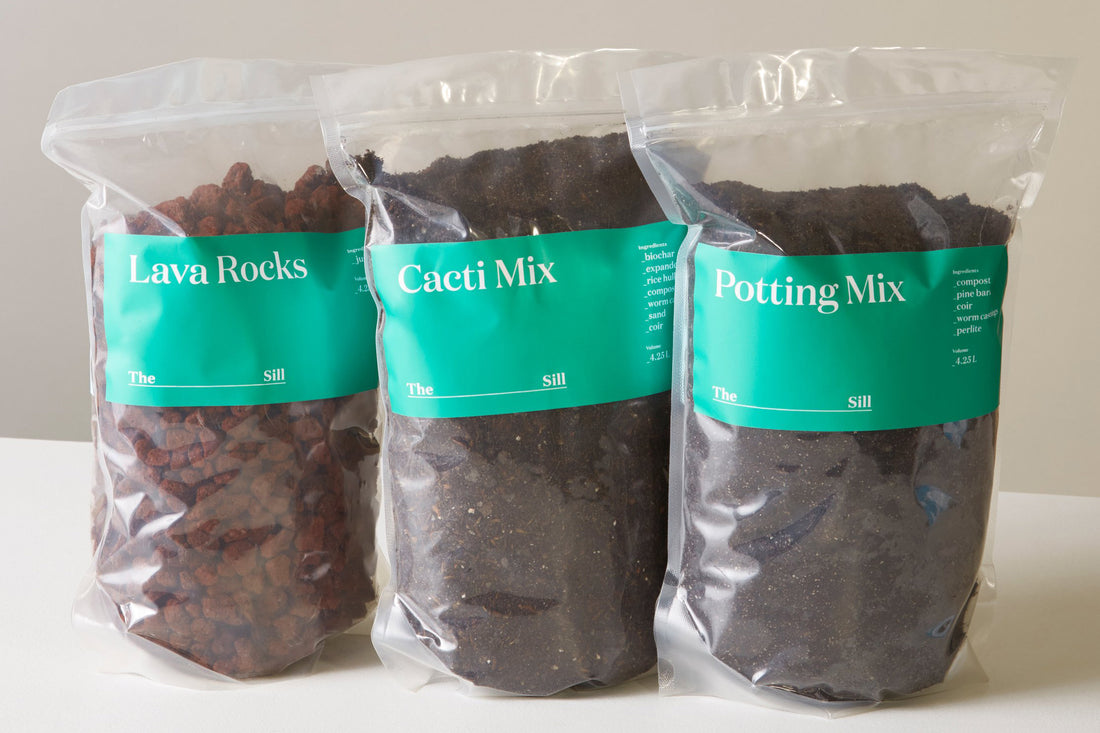
Common Care Questions
Plant Care: Potting Mix 101
Most plants need soil to live. It’s where their roots are and where they get their water from. But it may surprise you to learn that not all soil is soil. That is, although we see indoor plants potted in what looks like brown, soily, dirt, they may actually be potted in something else.

Not all soil is created equally.
What’s the deal with soil?
Most plants need soil to live. It’s where their roots are and where they get their water from. But it may surprise you to learn that not all soil is soil. That is, although we see indoor plants potted in what looks like brown, soily, dirt, they may actually be potted in something else. Generally known in the horticulturist community as “potting mixes” or “artificial potting media”, this 1960’s invention has been in wide use since then for it’s lightweight, weed-free properties and its ability to sustain seemingly any plant.
You may be thinking “why not just use outdoor soil for my indoor plants?” The truth is there are issues with that (see next paragraph), making artificial potting media superior. Allow us to explain.
When soil is taken from outdoors to indoors, you’re taking in all the critters that live in that soil too — critters that would love to eat your plants. You also run the risk of tracking in a soil-borne disease that may kill your plant. On top of all that, outdoor soil is primarily composed of clay, sand, and silt which are not only quite heavy but also prone to congealing and hardening when they dry out completely. Doesn’t sound so great for your indoor plant, does it?
Who came up with potting media/mix?
While we don’t know the first, we do know the best. The invention of Cornell Mix in the 1960’s by James Boodley & team at Cornell University catapulted the houseplant industry into life. The Cornell Mix formula is the basis of most horticulture mixes today. It provides the lightweight, weed-free media that allowed large-scale production of not just food crops, but any crop. Suddenly, large scale plant propagation was possible. Ornamental tropical foliage gained popularity soon after.
What’s in potting media/mix?
Most general potting mixes contain mostly peat, along with perlite and compost. Different mixes may have vermiculite, wood chips, sand or other materials added.
Breakdown by component:
Peat — the basis of most mixes and used in high proportions. Spongy and holds water.
Perlite — white, light, pebbles formed from superheated volcanic glass. Aids in aeration and water control.
Sand — silicon dioxide. Aids in water drainage.
Vermiculite — helps hold water and provides a slow leak of micronutrients and places for fungi/microbes to aid the plants growth.
Wood chips/Bark — decaying organic matter that provides a slow release of macronutrients and is a “denser sponge” than peat. If cut coarse, can aid in drainage.
Compost — nutrient-rich and microbe rich matter that aids in plant growth. Smells earthy.
Glass/Rocks — cheap filler found in not-so-great mixes. Although the rocks could provide a trickle of micronutrients, their weight is enough to make them a lousy ingredient.
What media should you use?
What media you use really depends on where you grow your plants. For example, you will want to use a potting mix to grow plants, herbs and vegetables that are indoors. Soil is best for any outdoor planting in your herb or vegetable garden. Why? Soil is heavier than potting mix and will add unnecessary weight to your containers. It could even be detrimental to your plants health; indoor plants need good air circulation in their roots system and using soil in a planter that is often too heavy and compact makes it virtually impossible for plant roots to spread and blocks moisture from penetrating the soil. As a result, diseases and bacterias can easily creep on your plant and attack it — essentially, your plant could die.
In addition, different plants will sometimes prefer different potting mix make up. For example, a succulent, snake plant or aloe will like a media that is more porous, such as perlite, that water can run through quickly and not hold as much water. (We all know how they prefer to be on the dry side, right?) On the other hand, ferns and mini terrarium plants will prefer a media with more peat, since it helps the soil to stay uniformly moist, which is what most tropical plants prefer.
Special mixes have been developed for different classes of plants. For example, succulent mix was developed with extra sand and coarser materials to aid in drainage for succulent growth. Orchid mix is mostly douglas fir bark, perlite and sphagnum moss. Although succulents can be planted in general potting mix without much fuss, orchids are epiphytes and must be planted in orchid mix, which resembles the trees that they grow on in the wild — they’re a little more high maintenance.
Bottom Line
Potting mix is different from outdoor soil. It’s best to use potting mix for any indoor plants. Use one that gives your plant roots the preferred air, moisture and nutrition balance it needs. Soil from the outdoors is heavy and is best used for outdoor gardening.

Words By The Sill
Empowering all people to be plant people—a collection of articles from The Sill's team of plant experts across a variety of plant care topics to inspire confidence in the next generation of plant parents. Welcome to Plant Parenthood™.
Do Some Plant Shopping